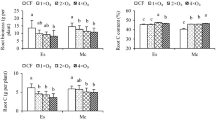Abstract
Surface ozone (O3) concentrations have proved to be difficult to control and regional (03) concentrations appear to be increasing in many parts of the world. Eucalyptus species are widely used as plantation trees in many regions that have Mediterranean, warm temperate and subtropical climates. An increased knowledge of the effects of tropospheric O3 on Eucalyptus trees may assist in the management of these plantations. The present study was set up to evaluate injury and measure growth reduction caused by O3 in eight Eucalyptus species. Seven month old saplings were exposed to diumally varied concentrations of 26 or 172 nil−1 (03) (7h mean) 7h day−1, 5 days in every 14 days, for 18 weeks. The plants were grown in open top field chambers fitted with rain excluders. Significant differences were found between the responses of different species. There was no visible injury or dry weight reduction in E. globulus. However O3 exposure caused a 30% weight reduction and 90% leaf injury in E. microcorys. E. gomphocephala also experienced a 30% weight reduction but no significant leaf injury. Hence Eucalyptus plantations in regions with the potential for photochemical smog formation, such as some of the rapidly developing industrialising nations in Asia and South America, will need to consider O3 tolerance when selecting plantation trees.
Similar content being viewed by others
References
Brimblecombe, P.: 1987, The big smoke, Routledge, London.
Bytnerowicz, A. and Grulke, N.E.: 1992, Physiological effects of air pollutants on western trees, in, The responses of western forests to air pollution, eds. R.K. Olson and D. Binkley, Springer-Verlag, New York, 189–270.
Chappelka, A.H. and Chevone, B.I.: 1992, Tree responses to ozone, in, Surface level ozone exposures and their effects on vegetation, ed. A.S. Lefohn, Lewis Publishers, Chelsea, MI. 271–324.
Elkiey, T. and Ormrod, D.P.: 1987, Water, air and soil pollution 36, 365–370.
Environmental Protection Authority, New South Wales.: 1994, Quarterly Air Quality Monitoring Report, Environmental Protection Authority, Sydney.
Haagen-Smit, A.J.: 1958, Science 128, 869–878.
Hanson, G.P.: 1972, Lasca Leaves 22, 86–89.
Heagle, A.S., Body, D.E., Heck, W.W.: 1973, J. Environ. Qual. 2, 365–368.
Heggestad, H.E. and Middleton J.T.: 1959, Science 129, 208–210.
Hertel, G.D., Eagar, C., Medlarz, S.A., McFadden, M.W.: 1992, The effects of acid deposition and ozone on forest tree species in the eastern United States: results from the forest response program in Forest decline, eds. R.F. Huettl and D. Mueller-Dombois, Springer-Verlag, Berlin, 54 -65.
Hough, A.M. and Derwent, R.G.: 1990, Nature 344, 645–648.
Kress, L.W. and Skelly, J.M.: 1982, Plant Disease 66, 1149–1152.
Krupa, S.V. and Manning, W.J.: 1988, Environ. Pollut. 50, 101–137.
O'Connor, J.A., Parbery, D.G., Strauss, W.: 1975, Environ. Pollut. 9, 181–192.
Ogner, G.: 1993, Environ. Pollut. 82, 197–200.
Reich, P.B.: 1987, Tree Physiology 3, 63–91.
Reiling, K. and Davison, A.W.: 1992, New Phytol. 120, 29–37.
Runeckles, V.C. and Chevone, B.I.: 1992, Crop response to ozone in Surface level ozone exposures and their effects on vegetation, ed. A.S. Lefohn, Lewis Publishers, Chelsea, MI., 189–270.
Schenone, G. and Lorenzini, G.: 1992, Agric. Ecos. and Environ. 38, 51–59.
Sokal, R.R. and Rohlf, F.J.: 1981, Biometry, W.H. Freeman & Co., New York.
Tingey, D.T., Standley, C., Field, R.W.: 1976, Atmospheric Environment 10, 969–974.
U S Environmental Protection Agency: 1994, National Air Quality and Emissions Trends Report, 1993, U S Environmental Protection Agency, Research Triangle Park.
Woodward, A.J., McMichael, A.J., Guest C.S.: 1993, Air quality goals for ozone: environmental, economic and social impact assessment: discussion document, University of Adelaide, Adelaide.
Zacharin, R.F.: 1978, Emigrant eucalypts: Gum trees as exotics, Melbourne University Press, Melbourne.
Author information
Authors and Affiliations
Rights and permissions
About this article
Cite this article
Monk, R.J., Murray, F. The relative tolerance of some Eucalyptus species to ozone exposure. Water Air Soil Pollut 85, 1405–1411 (1995). https://doi.org/10.1007/BF00477178
Issue Date:
DOI: https://doi.org/10.1007/BF00477178




